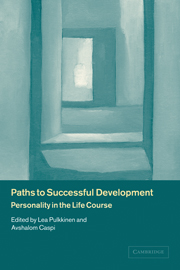Book contents
- Frontmatter
- Contents
- List of contributors
- Personality and paths to successful development: an overview
- Part I Temperament and emotion regulation
- Part II Formation of social relationships
- Part III Continuity in individual life paths
- Part IV Environmental contributions to personality development
- Part V Life transitions
- 10 Developmental regulation of life-course transitions: a control theory approach
- 11 Social selection, social causation, and developmental pathways: empirical strategies for better understanding how individuals and environments are linked across the life-course
- 12 Pathways through challenge: implications for well-being and health
- Part VI Personal goals and well-being
- Index
- References
10 - Developmental regulation of life-course transitions: a control theory approach
Published online by Cambridge University Press: 22 September 2009
- Frontmatter
- Contents
- List of contributors
- Personality and paths to successful development: an overview
- Part I Temperament and emotion regulation
- Part II Formation of social relationships
- Part III Continuity in individual life paths
- Part IV Environmental contributions to personality development
- Part V Life transitions
- 10 Developmental regulation of life-course transitions: a control theory approach
- 11 Social selection, social causation, and developmental pathways: empirical strategies for better understanding how individuals and environments are linked across the life-course
- 12 Pathways through challenge: implications for well-being and health
- Part VI Personal goals and well-being
- Index
- References
Summary
A control theory approach
In this chapter a control-theoretical approach to developmental regulation in adulthood is proposed (Heckhausen, 1999). The first section addresses the fundamental challenges posed for the individual's developmental regulation across the life-span, as they result from the general shift in the developmental ecology towards greater risks for decline and fewer chances for growth at increasing age levels during adulthood. In this section, I also discuss a repertoire of control strategies based on the life-span theory of control (Heckhausen and Schulz, 1995; Schulz and Heckhausen, 1996) and their orchestration by the individual's attempts to optimize development in terms of maximizing age appropriateness, manage inter-domain trade-offs, and maintain diversity. After this wide-angle view of life-span development and its regulation, the chapter's perspective zooms to the pursuit of major developmental goals. For each developmental goal there is an age-based trajectory of opportunities and constraints, which reflects first increasing, then peaking, and finally decreasing potential to realize the respective developmental goal (Heckhausen, 2000a). Based on this analysis, an action-theoretical model of developmental regulation around developmental deadlines is introduced. Exemplar empirical evidence for age-graded action cycles of engagement and disengagement with developmental goals in the domain of childbearing and of partnership is discussed.
Fundamental challenges for developmental regulation
The life-span theory of control, developed by Heckhausen and Schulz (1995; Schulz and Heckhausen, 1996) focuses on the individual as the agent in development (see also Lerner and Busch-Rossnagel, 1981; Brandtstädter, 1998).
Information
- Type
- Chapter
- Information
- Paths to Successful DevelopmentPersonality in the Life Course, pp. 257 - 280Publisher: Cambridge University PressPrint publication year: 2002
References
Accessibility standard: Unknown
- 17
- Cited by
